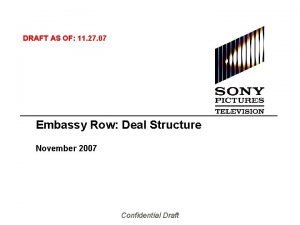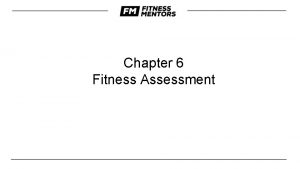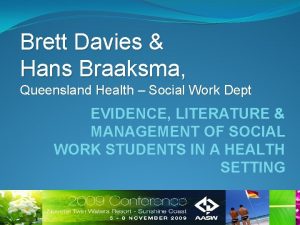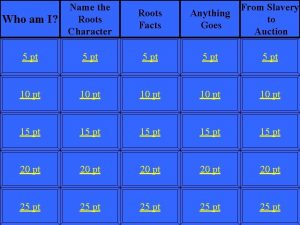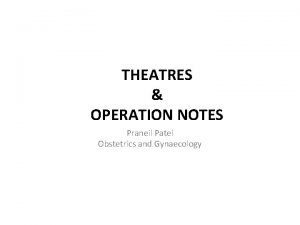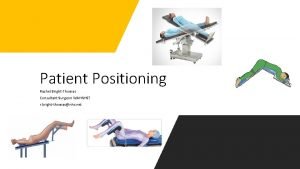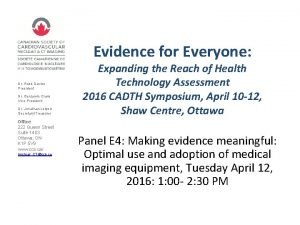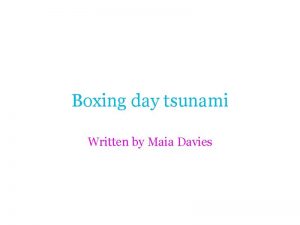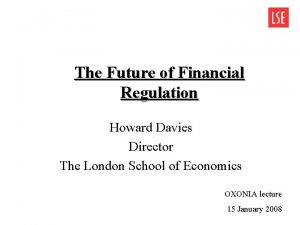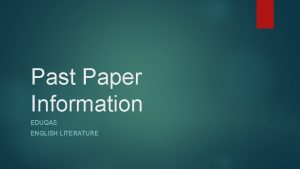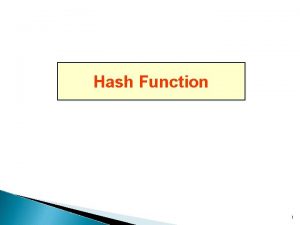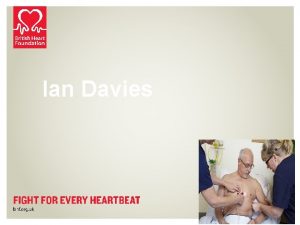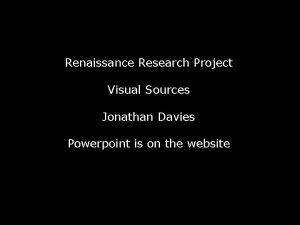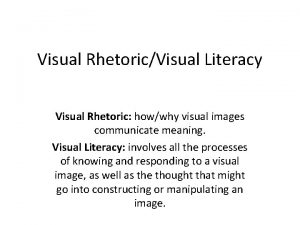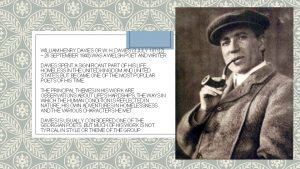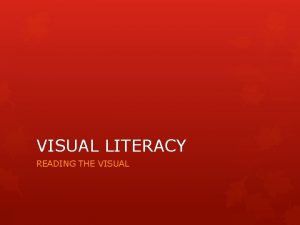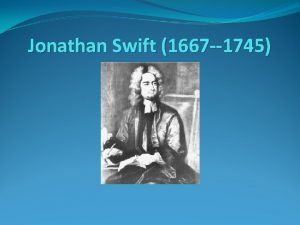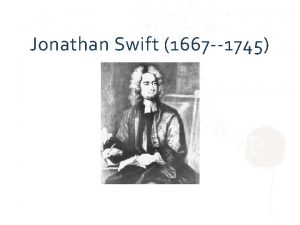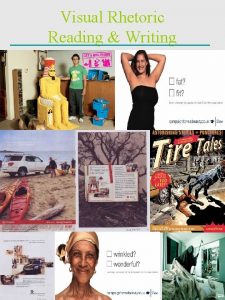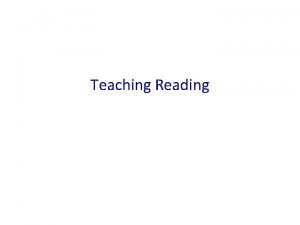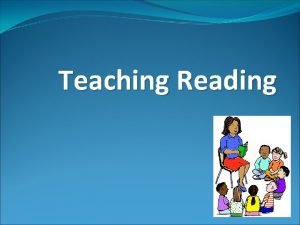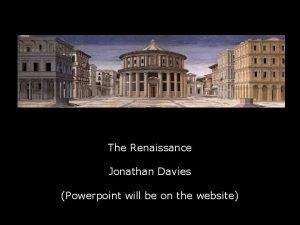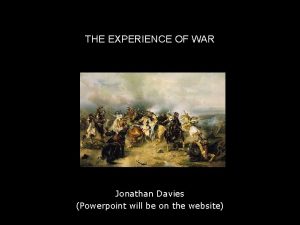TEACHING VISUAL IMAGES READING IMAGES Jonathan Davies University






















- Slides: 22

TEACHING VISUAL IMAGES READING IMAGES Jonathan Davies (University of Warwick) 12 March 2010

CONTEXT • My research focuses on the history of Tuscany between c. 1350 and c. 1650. • I teach undergraduate modules on Florence and Venice in the Renaissance, the Renaissance in Europe, and Gender in Europe 1350 -1650. • I teach an MA module on Violence in Early modern Europe. • I also contribute to the core modules of the History Department and the Centre for the Study of the Renaissance. • In each module I use visual images.

CONTEXT • This is an optional class for the ‘Theory, Skills and Methods’ History MA core module at Warwick. • The students are studying a variety of periods from the early modern to the contemporary. • They are also studying a variety of places: Britain; Europe; the wider world. • Most of them have not used images as evidence before.

AIMS OF THE CLASS • To make students aware of the value of visual images to historians. • To encourage students to think critically about visual images. • To make students aware that visual images could have been read differently in the past.

Why should historians use visual images?

Seeing currently occupies a paradoxical position in the new sensory history. On the one hand, it is the most familiar of the five senses, the perceptual register that comes to mind most readily and easily. It is also the sense with the longest and deepest historiographical paper trail. Whereas smells, touches, tastes, and sounds have only recently begun to emerge as explicit topics of historical analysis, visual images now constitute a thoroughly conventional evidentiary resource (and not just in the highly circumscribed sense of images as illustrations). James W. Cook, ‘Seeing the Visual in U. S. History’, The Journal of American History 95. 2 (2008), 432 -441 (p. 432).

What questions can we ask of visual images? Susan Hilligoss, Visual Communication: A Writer’s Guide (London, 1999), pp. 32 -35.

Rhetorical Purposes • Where does the image appear? [Where was the image located? Who had access to it? ] • What is the image’s purpose? • Does it document a situation, event, or condition? • Is it conceptual? If so, what is its point? • Does it specifically support an appeal to buy something? • Is the image realistic, like a photograph or more stylized, like a cartoon or caricature? • If the image is realistic, do you detect any types of distortion? Describe any features that may be distorted.

Rhetorical Purposes • How polished or “professional” is the image? • What tone does the image project? • How seriously are we to take this image? Explain why. • Who do you think are the intended viewers of the image? What features or context suggest this audience? • Who do you think produced the image? Is the artist/creator stated? • What would you say your relationship is to the producer or producers? Do you think they understand you, as a viewer?

Overall Design • What draws your eye first? • What does the dominant part of the image portray? • What is in the centre of the image? • What is shown in front and larger? What is behind and smaller? • What is shown in the upper half? the lower half? • Are portions more blurred? Are there very distinct parts in sharp focus?

Overall Design • Is there “empty” space? What does the empty space frame? • Are some areas or shapes very large? Are others very small? • Describe the major shapes and lines created. Consider what effect the shapes and lines create. • Describe the overall arrangement of parts. Are they ordered symmetrically or otherwise balanced against each other?

People and Images • Who is portrayed? Describe your inferences from each feature of the person(s) - age, details of dress, gender, ethnicity, class, posture and stance, portions of the body shown, tilt of head, facial expression, gesture of hands. • What is the person looking at? Follow his/her gaze or eyeline. Does he/she look toward something else in the image? or out of the picture? What do you make of the direction of the gaze?

People and Images • If there are two or more people, what features suggest their relationship to each other? • If there are two or more people, does one seem dominant? How is this expressed? • From what angle are the people shown? Do you seem to look down on them, as if they were below the viewer? Look up at them? Look right at them?

People and Images • Are people shown close up or far away? What emotional effect does this have? • What do you consider to be your relationship as viewer to the person or people shown? Do you empathize with them or not? Explain why.

Setting • If the image has a distinct background, describe it. • How does it relate to the dominant focus of the images, especially people, if any? • What time and place does the image suggest? What is the effect of this setting? • Is anything “out of place” in the image? What do you make of the incongruity?

Symbols and Signs • Are there items or features in the image that might mean more than themselves? Consider connotations and associations of particular objects or features in the image. Relate them to the rest of the image.

Colour • Describe the colours, or absence of colour, in the image. • Where is colour applied? • Is the colour realistic, in your view? If not, describe why you think it is not. • How does colour, or its absence, make you feel about the image? • What previous associations do you have with the colours used? How do those affect your understanding of the image?

Text • If the image includes text, such as headlines, labels, captions, or paragraphs of explanation, relate the text to the image. • In what ways does the text help you make sense of the image? Does it answer questions about the image, or only raise more questions? • What is the personality and tone of the typography, or the fonts that the text uses?

Story • What is the story being told in the image? Consider the people and objects in the image and their relationships to each other, the viewer, the setting and the text. • Who can relate to this story? Who may not find it believable or interesting? • Who or what is excluded from the image? Why? • What attitudes - social, political, economic, cultural - are suggested in this image? Who benefits from the attitudes shown? Who does not?

Were images read differently in the past?

Starting in the 1970 s, moreover, major scholarly debates on the dynamics of gazing, the proliferation of surveillance, and the production of spectacle made it easier to appreciate that the province of seeing extends well beyond images. By the early 1990 s, this innovative but still-fragmented body of work had coalesced into a recognizable field of historical inquiry. No longer was seeing something that could be taken for granted as a mere condition of sentience or treated in vaguely universalist terms. The act of looking, we had come to realize, varied considerably across eras, institutions, media, social groups, and even nations. James W. Cook, ‘Seeing the Visual in U. S. History’, The Journal of American History 95. 2 (2008), 432 -441 (p. 432).

Michael Baxandall, Painting and Experience in Fifteenthcentury Italy, 2 nd ed. (Oxford, 1988), Chapter 2. Stuart Clark, Vanities of the Eye. Vision in Early Modern European Culture (Oxford, 2007) Bob Scribner, ‘Ways of seeing in the age of Dürer’, in Dagmar Eichberger and Charles Zika (eds), Dürer and his Culture (Cambridge, 1998), pp. 93 -117. Svetlana Alpers, The Art of Describing: Dutch Art in the Seventeenth Century (Chicago, 1983) Frantz Fanon, Black Skin, White Masks, trans. Charles Lam Markmann (1952; New York, 1967) James W. Cook, ‘Seeing the Visual in U. S. History’, The Journal of American History 95. 2 (2008), 432 -441. [With further reading on other countries and other periods]
 Thick description voorbeeld
Thick description voorbeeld Jonathan davies warwick
Jonathan davies warwick While reading activities
While reading activities Jonathan tyner
Jonathan tyner Static postural assessment
Static postural assessment Michael davies embassy row
Michael davies embassy row Davies test
Davies test Hash functions
Hash functions Dr brett davies
Dr brett davies Portrayer of captain davies in roots
Portrayer of captain davies in roots Lloyd davies position
Lloyd davies position Davies v waldron
Davies v waldron Lloyd davies position
Lloyd davies position Dr ross davies
Dr ross davies Davies vs mann
Davies vs mann Maia davies
Maia davies Heather higinbotham davies
Heather higinbotham davies Howard davies (director)
Howard davies (director) Eduqas english literature past papers
Eduqas english literature past papers Justice jennifer davies
Justice jennifer davies Sha256 collision probability
Sha256 collision probability Josh davies work ethic
Josh davies work ethic Gavin davies imperial
Gavin davies imperial





